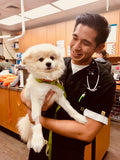What is Keratoconjunctivitis Sicca, aka Dry Eye Syndrome in dogs?
Keratoconjunctivitis sicca (KCS) is a condition that is also commonly referred to as dry eye. It is a common eye condition resulting from inadequate production of the aqueous portion of the tear film by the lacrimal gland and/or gland of the third eyelid. Often it is an immune-mediated disease that damage the tear producing glands with an inherited genetic component. This is the most common cause of KCS and is poorly understood. The body's immune system attacks the cells that produce a portion of the tear film resulting in decreased production.
Clinical signs:
Most dogs with KCS start to develop the following clinical signs:
- painful, red, swollen, irritated eyes
- squint, blink excessively or hold the eyes shut, due to pain from dry blinking
- dull, lusterless appearance due to the corneal drying
- thick, yellowish, mucoid discharge present as a result of the decrease in the aqueous (watery) component of the tear film
- secondary eye infections
Usually, this disease affects older and middle age dogs, however, some dogs can be born with this disorder. Additionally, one eye may looks to be worse than the other, even when both eyes are affected. If you pet suffers from chronic or recurrent eye ulcers, conjunctivitis, or eye injuries, definitely get checked out by your local veterinary and tested for KCS.
Treatment:
There is no cure for Dry Eye Syndrome in dogs, only management. The goal of treatment of KCS is to increase tear production and hydration of the eye, as well as decrease potential secondary bacterial infections commonly affecting pets with dry eye syndrome.
1.
The most important treatment for KCS are immunomodulating topical medications, such as cyclosporine (Optimmune) and tacrolimus. These topical medications work to decrease autoimmune response and inflammation at the source and help stimulate and allow the pets’ own tear ducts (lacrimal glands) to produce tears. This is important because artificial tears do not contain the nutrients and enzymes that are present in natural tears, so the return of natural tear production is vital. This medication needs to be given consistently for life and work well in about 85% of dogs with KCS.2.
Artificial tear preparations are often indicated to supplement the deficient tear film and make your pet more comfortable. Allows lubrication and hydration of they eye when the tear ducts are not working as well.3.
Topical antibiotics and anti-inflammatories (sometimes steroids) are indicated when corneal staining shows NO ulceration. Topical antibiotics and steroids reduce inflammation and infection of the conjunctival and corneal surfaces and reduces the long-term scarring effects. WARNING: steroids cannot be used in the face of ulcers because they may decrease healing and increase the spread of infection, worsening the ulcers to cause potentially devastating eye issues.4.
Oral Supplements to maintain tear production and eye circulation: Supplement such as Qbow Eye and Vision help the body to manage optimal tear production and eye circulation systemically. This supplement helps the body to increase tear production as immunomodulating agents decrease inflammation of the tear ducts, allowing the ducts and eye to return to normal function. You can find this supplement linked below:
These supplements contain natural herbal ingredients such as mulberry, cassia, wolfberry, dendrobium, common yam, and rehmannia are incorporated to promote circulatory and lacrimal health to reduce excessive tear secretions and staining, prevent and delay the onset of cataracts, and reduce irritation from dry eyes.
As stated above, there is no cure for this disease, however, management for a happy, healthy, pain-free eye, to start with, can be as follows:
1. Optimmune: apply into each eye twice a day for life
2. Artificial tears: apply into each eye twice a day for life
3. Qbow Eye and Vision supplement: give orally twice a day for life
Prognosis:
Most patients with keratoconjunctivitis sicca do well if medications are administered on a timely basis. In roughly 5-10% of cases, medications first started on for the disease can lose effectiveness, necessitating an increase in dosage, frequency, or change in medications.
I hope this article helped you to understand and manage your pet with dry eye disease, it can be one of the most uncomfortable disease for your pet, and frustrating to deal with until well managed. However, once an effective management regimen is found, your pet can return to a happy, healthy, pain-free lifestyle. As always, feel free to reach out to our team on Facebook, Instagram, email, or in the comments section below if you found this article helpful or have any questions!
About the Author:
 Dr. Zonram Liao D.V.M. is a Southern California native, and earned his undergraduate degree from University of California, San Diego before obtaining his veterinary degree from Ross University School of Veterinary Medicine. He is not only a firm believer in the use of supportive care supplements to improve the health and happiness of his patients, but also is a strong advocate of the benefits of preventive care medicine for his patients as well. During his free time, Dr. Liao enjoys spending his time outdoors fishing and hiking, playing basketball, watching movies, cooking, traveling, and trying new foods.
Dr. Zonram Liao D.V.M. is a Southern California native, and earned his undergraduate degree from University of California, San Diego before obtaining his veterinary degree from Ross University School of Veterinary Medicine. He is not only a firm believer in the use of supportive care supplements to improve the health and happiness of his patients, but also is a strong advocate of the benefits of preventive care medicine for his patients as well. During his free time, Dr. Liao enjoys spending his time outdoors fishing and hiking, playing basketball, watching movies, cooking, traveling, and trying new foods.

